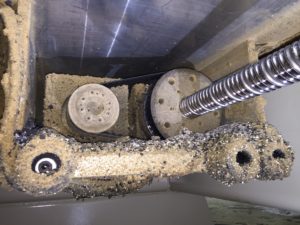 Are you headed toward ball screw failure?
Are you headed toward ball screw failure?
Catch a problem before it turns into disaster with these seven ball screw failure warning signs
Replacing a CNC ball screw can be a costly expense. It’s not just the price of the ball screw and cost of labor, but the down time as well. This is especially true when you are experiencing an unexpected ball screw failure.
When your machine seizes completely, you have no choice but to bring your equipment offline. Then, you wait until a replacement or repair is completed. Unexpected downtime compromises your production schedule. The result is reduced output and lower revenue.
But what if you could avoid ball screw failure by recognizing the warning signs? You could address the concern before a major malfunction! Certainly, you’d save time (scheduling downtime when its convenient) and money (no need to expedite an emergency repair or replacement).
While there are a variety of reasons why ball screws fail, below are the seven most common warning signs to watch out for.
Recognize the Warning Signs
Heat discoloration on lead or balls of ball screw is often cause by poor lubrication. First, ensure you are lubricating according to manufacturer recommendations. Then, regularly check your lube lines, fittings, and connections for damage. Lubricating as often as recommended is one thing. Making sure the lubrication is getting to where it needs to be is another matter.
Rough/noisy operation is likely due to an inadequately lubricated or misaligned ball screw. It could also be caused by worn or damaged ball bearings. If your CNC machine wobbles, chatters, growls, etc., prompt attention is required. Contact a reputable ball screw repair company and request a clean, flush, and inspection – before total ball screw failure.
Loud clicking sounds coming from ball nut tubes can indicate excessive build up under way covers – or a damaged, dented or bent return tube.
Excessive vibration during operation can be an indicator of a bent screw shaft, misaligned bearing housings, or an unlevel machine.
Surface distress such as pitting, spalling, or skid marks is typically caused by contaminants – and is a sign that your ball screw is deteriorating.
High power draw could be caused by insufficient lubrication, ball recirculation problems, or excessive preload.
Poor cut accuracy is indicative of ball screw wear. Examples include hole out-of-round problems or jagged/jiggly edges. Operators may have to slow feed rates to compensate for cut accuracy issues. If this is your case, or you are completely unable to produce a quality part, schedule an inspection as soon as possible.
Replace or Repair?
Take action while your ball screw is salvageable. OEM replacement is an option, but it is usually not necessary. Often, the most cost-effective solution is to get your ball screw repaired. You can save more than sixty percent when repairing instead of replacing. Of course, catching the warning signs early helps prevent ball screw failure, allowing you to schedule ball screw service as part of your regular preventive maintenance plan.